How Come My Ssd Does Not Register On Userbench
Nonetheless hankering for the day that yous pulled your new PC out of the box, plugged it in and it just worked? Over time and apply, your PC can wearisome down. This could be due to obsolete or corrupt hardware, software problems or all of these things. UserBenchmark.com can can place many of these problems and help y'all to achieve the best performance possible from your Windows PC. This user guide answers the following questions:
UserBenchmark.com tin rapidly found whether your PC is underperforming and propose likely hardware and software issues. Test how fast your processor, graphics card, storage drives and memory are past running the free UserBenchmark Speed Test.
Tip: Closing unnecessary programs and browser tabs earlier clicking 'run' will keep background CPU usage downward and produce more than authentic results.


The test may take a upward to few minutes to run depending on your PC. After completion, your results volition be bachelor on UserBenchmark.com.
The following section explains how to interpret the results for an example UserBenchmark run.
Headline Results

This detail PC has a reasonable desktop score of 39% and then information technology is suitable for most day to day activities such every bit using Microsoft Part and spider web browsing. Depending on exactly how the PC is used, it may also be sufficient as a minimal workstation PC 28%. However, the system is unsuitable for PC gaming as information technology only scores 17%.
Full details on each of the category calculations are bachelor hither.
High Level Summary
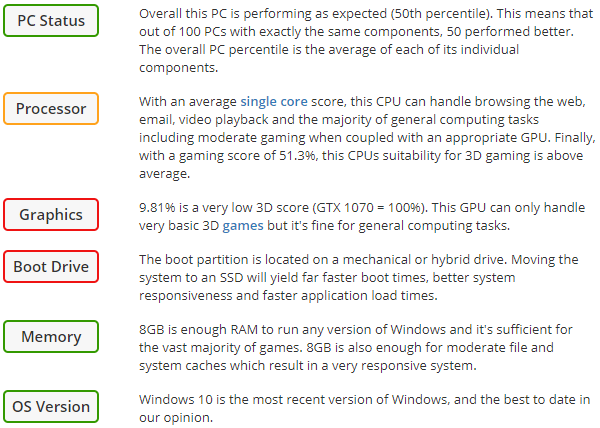
The high level summary at the outset of the results page explains the relative functioning of this PC compared to other PCs with the same components (PC Condition). This is useful in highlighting whether there is a functioning result with this item PC'south hardware. The summary also points out other significant items such as the type of tasks this PC is most suited to.
In this example, the PC is in reasonable status, performing as expected and running the latest version of Windows. The processor is highlighted in amber, indicating that its operation is about boilerplate. The summary also suggests that the graphics capabilities are on the depression side and that consideration should be given to incorporating a SSD boot bulldoze.
Processor Score
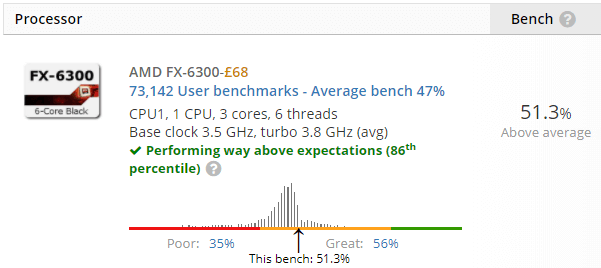
This AMD FX-6300 processor scores a benchmark of 51.3% based on single, quad and multi-core speed tests. This is higher than the average of all other benchmarks for this processor (47%). The graph shows that this CPU is actually performing in the 86th percentile, which is way to a higher place expectations.
Graphics Card Score
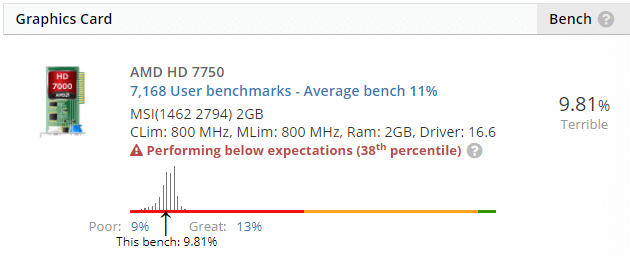
As emphasized in the loftier level summary, the graphics for this PC are weak, scoring an underwhelming 9.81% which is a bit on the low side just withal reasonably consistent with the average score for the Hard disk 7750 (xi%). Playing 3D games would be a struggle, if non an impossibility with this carte and it may even be an effort to play some Hd movies. This PC's graphics score, and therefore gaming experience, could be improved by upgrading to a better GPU.
Hard Drive Score
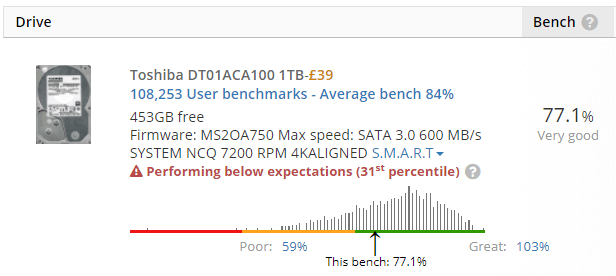
In accented terms, this Toshiba hard disk seems is performing reasonably well with a benchmark of 77.i% merely the boilerplate score for all Toshiba DT01ACA100 drives (based on 108,253 samples) is 84% so this particular drive is in the bottom 31st percentile. It'southward possible that there were some background processes accessing this bulldoze during the criterion or information technology may be that the criterion was run on a slower innner partition. Re-running the exam after a reboot would reduce the chances of background processes interfering with the benchmark results.
You can take the following bones steps to ameliorate the speed of your PC if your components are performing below their potential.
If poor functioning is stemming from a low CPU or boot drive status, some free and effective means of improving PC operation involve clearing out unwanted software and files. You may like to try the post-obit:
a. Use Windows Tools
-
Uninstall redundant programs. Use Windows Task Manager and check deejay load (Windows 8 onwards) to identify unnecessary active programs consuming processing power. Remove the programs via the Control Console.
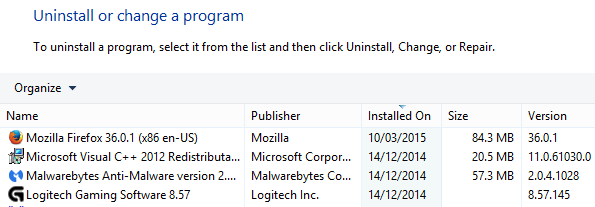
-
Reduce the programs that unnecessarily automatically first when the PC is powered upward, thereby reducing the PC start upward time. This can be accessed via the task managing director 'Start upwards' section for Windows eight onwards or by typing 'msconfig' in the startup carte du jour for earlier versions.
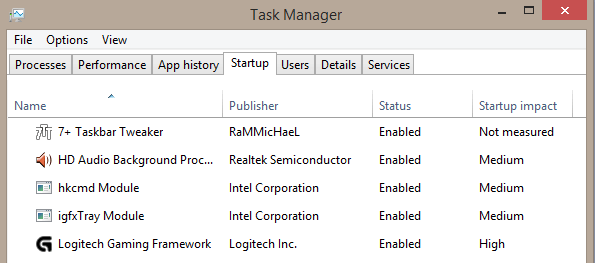
-
Purge unnecessary files from the drives using Windows Deejay Cleanup (user guide). Access hard disk drive cleanup via settings, control console, administrative tools and then Deejay Cleanup. Delete unnecessary program files and arrangement files (east.g. previous Window installations) via this method.
-
Troubleshoot Windows via the control panel action heart to help place Windows-related performance bug east.g. installing a Windows update may be advisable.

-
Check Windows Event Viewer. This is a record of the PC'southward alerts and notifications, that can be sorted in guild of importance. In Windows 10, this can be constitute past right clicking the Windows start icon (or from the Win+X power card) and selecting 'Event Viewer'. A full log of 'Administrative Events' is listed under the 'Custom Views' directory, or for a more than salient list of events, await under 'Windows Logs' then 'System'.
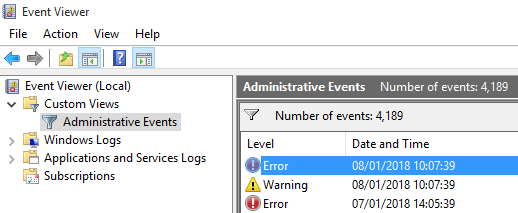
b. Use free online tools, such equally:
-
O&O ShutUp10 is a portable antispy tool for Windows 10 that helps to retain control over personal data besides as reducing bloatware that ships with default installations of Windows. Highly recommended for new builds.
-
LatencyMon checks a PC's core responsiveness by measuring the latencies and hard page faults of installed drivers. Latency bug tin result in audio baloney such as clicking and crackling as well every bit jerky graphics and an unresponsive organisation.
c. Practice practiced maintenance habits
-
Switch off the computer from time to fourth dimension as opposed to simply putting it to sleep (which maybe the default in your PC's ability plan). Switching the PC off forces all programs to close, including those which may exist running surreptitiously in the background, and clears out the memory.
-
Keep the PC physically make clean by clearing dust from air vents and the surrounding environment. Too much dust can cause hardware to overheat and work sub-optimally.
If yous require greater functioning from your PC or you doubtable that your hardware is faulty, you may look to upgrade some components. Whilst the instance PC discussed above is adequate for many desktop activities, it only scored 17% for gaming and did not have a SSD boot drive. Depending on how this PC is used, it may benefit from a new GPU and SSD. UserBenchmark can help place the best options whichever PC component is beingness considered for upgrade.
UserBenchmark's full list of components for: CPUs, GPUs, SSDs, HDDs, RAM and USB drives tin be sorted past functioning, value, popularity, budget, historic period etc. and filtered by make, capacity, vendor etc. to assist identify specifically which components are best for your needs.
Narrow downwardly the choice and compare ii components side by side, or one component against the average of the tiptop tier components with UserBenchmark's comparisons.
Comparing Components
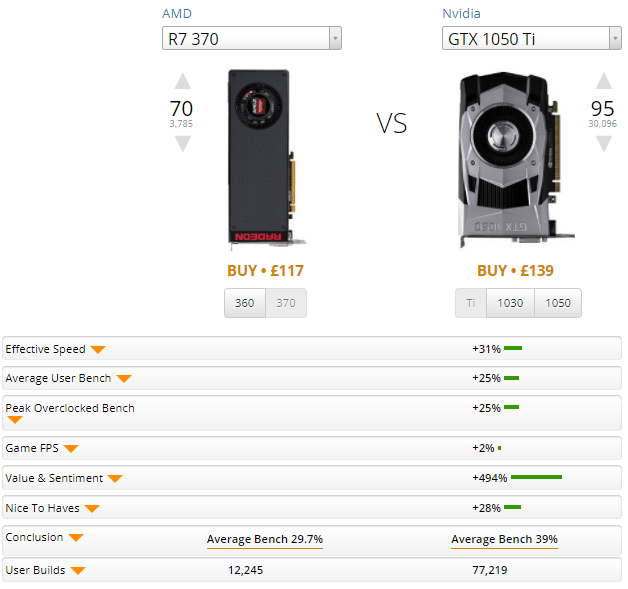
As an case, a comparison between two mid-range popular GPUs: the Nvidia GTX 1050 Ti and AMD R7 370, instantly reveals that the GTX 1050 offers significantly better value for money.
To meet how the upgrade may touch the UserBenchmark overall PC score before making a buy, use the Custom PC Builder tool.
Using Custom PC Builder

From your User run results page, just click on the 'Add to PC Build' button which conveniently adds the various components included in the results to the baseline build in the Custom PC Builder tool.
Play around with component upgrades in the 'Alternative build' column and see the prices and expected touch on PC benchmarks.
Likewise explore the real globe benchmark results of your proposed PC past clicking on load baseline/alternative benchmarks. Also as showing real world performance, these benchmarks reveal pop, and unpopular, component combinations. An uncommon combination may testify that there is little signal in adding a cut-border component to an ageing PC and a wildly unpopular combination may indicate incompatibility.
Upgrade candidate ane
In the following example, upgrading to a 1050 Ti would approximately double the gaming score to a respectable 33% at a price of $155.

Upgrade candidate 2
Spending a further $120 would buy the punchy NVIDIA GTX 1060-6GB and would enhance the expected gaming score to 52% if and so desired.
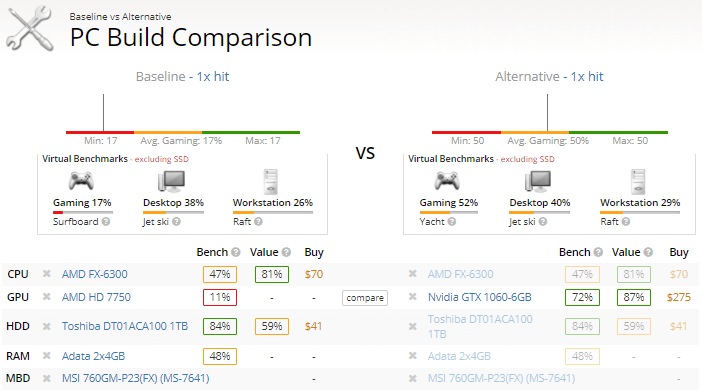
UserBenchmark of the month
The UserBenchmark Build tool quickly and freely allows the experimentation of any number of PC setups before making the ultimate purchase. For inspiration, check out some of the great builds featured here:
And then yous've taken on board the suggestions: y'all've cleaned upwards your PC, and yous've upgraded your graphics card. Now information technology's time to measure the results of your hard piece of work.
Run the Userbenchmark speed test over again and compare the latest results to your previous run results which can exist saved to your profile.
Good luck with your PC improvement journey and thank you for reading!
Nosotros sincerely hope you have institute this guide helpful. If you have, why non share UserBenchmark.com with your friends: brand sure their PCs are performing optimally and compare benchmarks.
How Come My Ssd Does Not Register On Userbench,
Source: https://www.userbenchmark.com/page/guide
Posted by: langleynamonsiver.blogspot.com


0 Response to "How Come My Ssd Does Not Register On Userbench"
Post a Comment